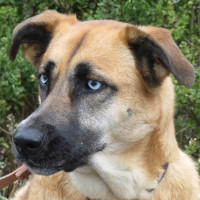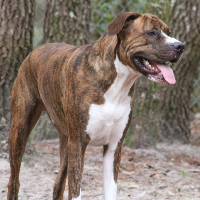Appearance of the Siberian Black Mouth Cur
|
| The Siberian Black Mouth Cur is a large dog. They can be cream or yellow, a nod to their Black Mouth Cur lineage. Conversely, they can be dark brown or gray (or even black) like their Siberian Husky parent. Eye color also varies. He may have brown eyes like the parent breed Black Mouth Cur, or have a “glass” eye (one brown and one blue) - a trait he may inherit from the parent breed Siberian Husky. His coat is also likely to be influenced by the dominant parent breed. It may inherit the short, smooth coat of the Black Mouth Cur. Conversely, it may inherit the slightly longer, denser double coat of the Siberian Husky's parent breed. Its tail curls over its back and its ears are erect. |
Temperament of the Siberian Black Mouth Cur
|
| The Siberian Black Mouth Cur is a rather serious dog. It takes him a while to get used to strangers. However, this makes him a good watchdog. He's not likely to be distant with his family. He's very intelligent, but housetraining may take a little longer with the Siberian Black Mouth Cur than with other breeds. However, start training him from an early age and reinforce his good behavior with praise and treats. He won't respond to punishment as a deterrent to bad behavior. He's not the type to bark a lot, but he'll let you know if something's wrong on his territory. Of course, once he's attached himself to his family, he's very affectionate with them. He can be gentle with other dogs, but he needs to be socialized from an early age so that he can spend time with other animals. |
Needs and activities of the Siberian Black Mouth Cur
|
| The Siberian Black Mouth Cur tends to be rather active; however, if left to its own devices, it will become lazy and start to put on weight. To keep him healthy, it's best to give him plenty of playtime and exercise. He'll adapt to the activities of an active family, like long walks and hikes. In fact, you'll probably get tired before he does on the hiking trail. If you allow him to play inside a fenced yard, make sure the fence is at least 1.80 m high and anchored at least 25 centimetres into the ground. Both breeds have a tendency to climb over fences and dig their way out. He'll also enjoy a trip to the dog park, but wait until he's fully trained. Don't forget that he's a hunter at heart and can be prone to wandering off when not on a leash or inside a well-built fence. |
Maintenance of the Siberian Black Mouth Cur
|
| The Siberian Black Mouth Cur's level of maintenance will largely depend on the dominant parental breed. If it inherits the short, straight coat of the parent Black Mouth Cur breed, the Siberian Black Mouth Cur will need little maintenance. It can be brushed once a week to remove any excess hair, and bathed only when necessary. If he inherits the dense double coat of the parent Siberian Husky breed, you'll need to brush him two or three times a week to rid his coat of excess hair. Expect him to “blow” his coat twice a year. In spring and autumn, you'll need to brush him daily. Brush his teeth two or three times a week to prevent tartar build-up on his teeth and bad breath; better still, to prevent tooth decay, brush his teeth every day. Note: you'll need to establish a grooming routine with him from the very beginning of his life. The Siberian Husky's parent breed can be sensitive to touch. Wipe his ears with a cotton ball once a week to remove excess dirt; also check for redness and odor. Trim his nails every two weeks, unless he wears them down naturally. |









 English (United Kingdom)
English (United Kingdom)